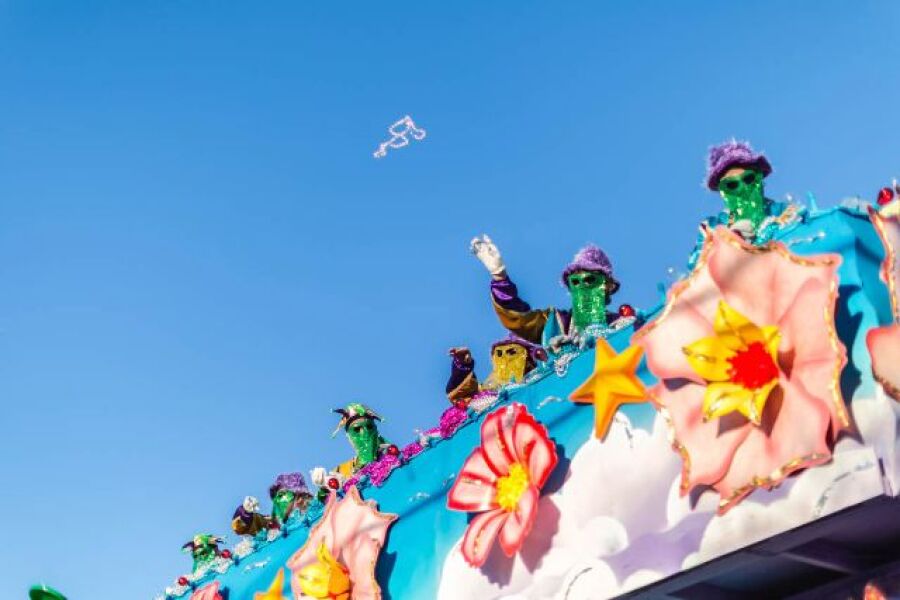Why is it called Mardi Gras?
If you have ever wondered why the New Orleans celebration is called Mardi Gras and not either “Fat Tuesday” (its literal translation) or Shrove Tuesday (the English name for the same holiday), its name reveals the long history of the celebration. The first recorded pre-Lenten celebration in New Orleans dates to 1699, while the city was part of New France, and for a century the French colonists held costumed parties and balls, precursors to the parades that began in the early 19th century. Even after the Louisiana Purchase in 1803, when New Orleans became part of the United States, the French name stuck.
When is it?
In 2019, the celebration falls on March 5, but just as Easter moves each year (since its timing is based on a lunar calendar), the timing of Mardi Gras does as well—it is always 47 days before Easter. The earliest Mardi Gras can take place is February 3, the latest is March 9.
What is with the beads?
Even if you’ve never been to New Orleans for the celebration, you know about the strands of colorful beads being tossed from floats. The tradition of “throws” is believed to have begun with sugared almonds before glass beads—traditionally in green, purple, and yellow—became popular. In recent years krewes have expanded their throws and some of the most coveted items are practically works of art: the hand-decorated high heels thrown by the all-female Krewe of Muses, the Krewe of Nyx’s glittery purses, and the famous painted coconuts of the historic Zulu krewe.
Wait, what’s a krewe?
These are the clubs that make Mardi Gras possible—the groups that underwrite the floats, organize the parades, and work with designers to create the costumes. There are more than 80 official krewes of various sizes, with the oldest dating back to the late 19th century. When AFAR Experiences visits New Orleans in March 2019, participants will be riding on a float with the Krewe of Orpheus, which counts Harry Connick, Jr. as one of its founders. The name Orpheus is a nod to the musical backgrounds of a number of its members.
How does New Orleans prepare for the celebration?
The preparation for each Mardi Gras begins almost as soon as the previous one is finished, with the design and construction of floats beginning even before the streets are cleaned. Most of the floats are built by Mardi Gras World/Kern Studios which offers tours year-round of their 300,000-square-foot warehouse in the Lower Garden District.
Meanwhile D&D Creations is busy sewing the elaborate, colorful costumes with their feathers and beads that are an essential part of the pageantry of Mardi Gras. The company works with more than 40 krewes and creates more than some 7,000 costumes each year. Visitors can learn firsthand how the elaborate beaded costumes for Mardi Gras Indians are created at a NOMGI Sip and Sew (NOMGI is short for New Orleans Mardi Gras Indians). Each class includes all the sewing materials you’ll need to create your own unique souvenir, snacks, and a musical performance by the Young Maasai Hunters Indians.
As the day gets closer, bakers are also called in to help get the party started. King cakes are a New Orleans specialty, served between Epiphany (January 6) and Mardi Gras—with icing decorated with sprinkles in green, purple, and yellow, the Mardi Gras colors. Inside each cake is a small plastic baby figurine. Whoever gets the slice with the baby will enjoy good luck and prosperity, though they also have a serious responsibility—purchasing a king cake for the next party or gathering. Dozens of New Orleans bakeries prepare king cakes, some following traditional recipes passed down through generations and others opting for novelties like flavored fillings—chocolate, banana, maple bacon. Ask any New Orleans resident and they’ll have one they recommend. We think the best approach is to visit a number of them, sample their cakes, and pick your own favorite.
What do I need to do to prepare?
If you want to be part of the Mardi Gras celebrations in 2019, now is the time to plan your trip—flights and hotels sell out early for America’s most famous party. While the AFAR Experiences trip to New Orleans for Mardi Gras, from March 2 to 4, has sold out, it is still possible to add your name to our wait list. If a space opens up, we will alert you so you can join us and enjoy insider access to the best of this magical city. The highlight of the trip will be the chance to ride on the Krewe of Orpheus’s float, a once in a lifetime opportunity.







